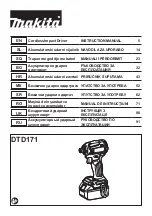
English |
19
3 609 929 B04 • 26.10.06
Connection of the Air Supply to the
Pneumatic Tool
Remove the closing cap
2
from the connector at the air
inlet.
Screw the hose nipple
3
into the connector at the air
inlet
4
.
To prevent damage to the internal valve components of
the tool, you should use an open-end spanner (size
19 mm) to apply a counterforce at the protruding con-
nector of the air inlet
4
when screwing/unscrewing the
hose nipple
3
.
Loosen the hose clamps
11
of the air inlet hose
12
. Slip
the end of the air inlet hose over the hose nipple of the
automatic quick hose connector
10
and tighten the
hose clamp again. Then slip the other end of the air inlet
hose over coupling nipple
13
and fasten the air inlet
hose by tightening the other hose clamp.
Screw a quick hose connector
14
in the air outlet of the
maintenance unit
15
. Quick hose connectors make
possible a quick connection and, when uncoupled,
thea shut off the air supply automatically.
Note:
Always connect the air inlet hose first to the
pneumatic tool, then to the maintenance unit.
Insert the coupling nipple
13
into the quick hose con-
nector
14
in order to connect the air inlet hose to the
filter/regulator-lubricator. Take care that you do not
start the pneumatic tool accidentally when connecting
the quick hose connector
10
with the hose nipple
3
.
Changing the Tool
Inserting
f
When you install the tool bit, take care that
the tool bit is seated securely on the tool bit
holder.
If the tool bit is not joined securely to the
tool bit holder, it may become loose and it may no
longer be controllable.
Slide the tool bit
9
over the drive square of the tool
holder
7
. Pay attention that the snap ring
8
engages in
the groove of the tool bit.
Use only tool bits with appropriate shank end (see
“Technical Data”, page 18).
f
Do not use adapters.
Removing
Pull off the tool bit
9
from the tool holder
7
. A seized tool
bit can be freed by applying light blows with a rubber
hammer.
Operating Instructions
Putting into Operation
The air tool operates optimally with a pressure of
6.3 bar (91 psi) measured at the air inlet with the tool
running.
f
Pay attention to the direction of rotation that
is set before switching on the pneumatic tool.
For example, when a screw is to be loosened and
the direction of rotation is set so that the screw is
tightened, this can lead to a strong torque reaction
of the pneumatic tool.
3
2
4
10
11
11
12
13
14
15
9
7
8
OBJ_BUCH-281-001.book Page 19 Thursday, October 26, 2006 10:40 AM
















































